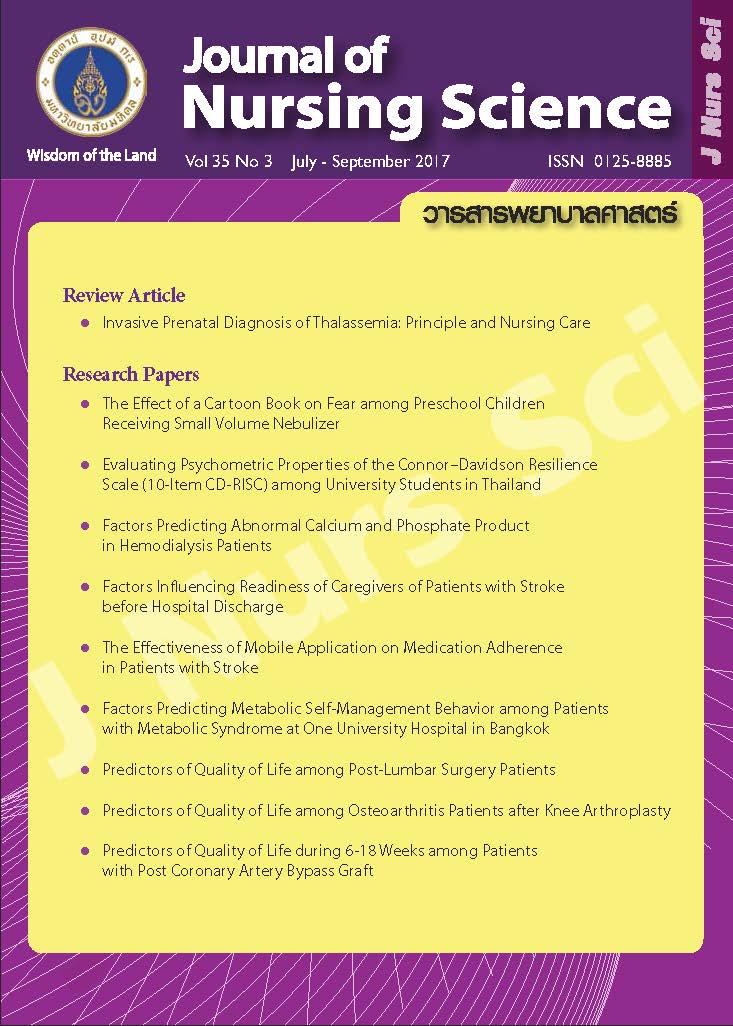Invasive Prenatal Diagnosis of Thalassemia: Principle and Nursing Care หัตถการตรวจวินิจฉัยโรคธาลัสซีเมียก่อนคลอด: หลักการและแนวทางการพยาบาล
Main Article Content
Abstract
Invasive prenatal diagnosis is the most common method of diagnosis of fetal congenital disease and anomaly, especially thalassemia, which is a major public health problem in Thailand.
Invasive prenatal diagnosis affects both physical and psychosocial aspects of pregnant women. Beside the complication of invasive method, pregnant women also feel fear and anxiety about the procedure and the test result since they received information of the procedure until the test was given. Nurses who take care of those pregnant women must aware the effect of the invasive prenatal diagnosis of thalassemia and give proper physical and psychosocial nursing care. The appropriate nursing care can increase effectiveness of the invasive procedure, decrease complications during and after the procedure, and alleviate the psychosocial effect.
The objective of this article was to present guideline of effective nursing care of pregnant women with invasive prenatal diagnosis of thalassemia both physical and psychosocial aspects: before, during, and after procedure.
บทคัดย่อ:
หัตถการตรวจวินิจฉัยก่อนคลอดเป็นวิธีการวินิจฉัยโรคหรือความผิดปกติของทารกในครรภ์วิธีการหนึ่งที่ทำบ่อยในสตรีตั้งครรภ์และมีแนวโน้มเพิ่มมากขึ้น โดยเฉพาะการวินิจฉัยโรคธาลัสซีเมียซึ่งเป็นปัญหาทางสาธารณสุขที่สำคัญของประเทศไทย
หัตถการตรวจวินิจฉัยโรคธาลัสซีเมียก่อนคลอดไม่เพียงแต่ส่งผลกระทบทางด้านร่างกายของสตรีตั้งครรภ์ เช่น อาจเกิดภาวะแทรกซ้อนภายหลังการทำหัตถการ ได้แก่ ถุงน้ำคร่ำรั่ว การติดเชื้อ การแท้ง เป็นต้น แต่หัตถการตรวจวินิจฉัยก่อนคลอดยังส่งผลกระทบต่อภาวะจิตสังคมของสตรีตั้งครรภ์ด้วย โดยสตรีตั้งครรภ์มักรู้สึกกลัวและวิตกกังวลเกี่ยวกับการทำหัตถการ ภาวะแทรกซ้อนที่อาจเกิดขึ้น รวมถึงกลัวว่าทารกในครรภ์จะเป็นโรคธาลัสซีเมีย ตลอดช่วงเวลานับตั้งแต่ได้รับข้อมูลเกี่ยวกับการตรวจวินิจฉัยก่อนคลอดจนกระทั่งได้รับผลการตรวจวินิจฉัย พยาบาลผู้ดูแลสตรีตั้งครรภ์ที่จะต้องได้รับการทำหัตถการเพื่อวินิจฉัยก่อนคลอดจึงควรตระหนัก และให้การดูแลสตรีตั้งครรภ์ที่ครอบคลุมทั้งทางด้านร่างกายและจิตสังคม ซึ่งนอกจากจะช่วยให้สตรีตั้งครรภ์ได้รับการทำหัตถการตรวจวินิจฉัยก่อนคลอดอย่างมีประสิทธิภาพ ช่วยลดภาวะแทรกซ้อนที่อาจเกิดขึ้นได้แล้ว การพยาบาลที่เหมาะสมยังจะสามารถช่วยลดผลกระทบทางด้านจิตสังคมที่จะเกิดกับสตรีตั้งครรภ์ได้ด้วย
บทความนี้มีวัตถุประสงค์เพื่อเสนอแนวทางการพยาบาลสตรีตั้งครรภ์ที่จะได้รับการทำหัตถการตรวจวินิจฉัยโรคธาลัสซีเมียก่อนคลอดที่มีประสิทธิภาพที่ครอบคลุมทั้งด้านร่างกาย จิตใจ และสังคมในระยะต่างๆ ตั้งแต่ได้รับข้อมูลเกี่ยวกับการตรวจวินิจฉัยก่อนคลอด ก่อนทำหัตถการ ระหว่างการทำหัตถการ และภายหลังการทำหัตถการ
Article Details
Copyright Notice: Nursing Science Journal of Thailand has exclusive rights to publish and distribute the manuscript and all contents therein. Without the journal’s permission, the dissemination of the manuscript in another journal or online, and the reproduction of the manuscript for non-educational purpose are prohibited.

Disclaimer: The opinion expressed and figures provided in this journal, NSJT, are the sole responsibility of the authors. The editorial board bears no responsibility in this regard.
References
2. Fucharoen S, Fucharoen P. Thalassemia in Thailand: problem and prenatal diagnosis. In: Ajjimakorn W, Thanantaseth C, editors. Fetal diagnosis and therapy. Bangkok: Pimdee Press, 1992; p.90-9. (in Thai).
3. Cederholm M, Sjödén PO, Axelsson O. Psychological distress before and after prenatal invasive karyotyping. Acta Obstet Gynecol Scand. 2001;80(6):539-45.
4. Sun JC, Hsia PH, Sheu SJ. Women of advanced maternal age undergoing amniocentesis: a period of uncertainty. J Clin Nurs. 2008;17(21):2829-37.
5. Tercyak KP, Johnson SB, Roberts SF, Cruz AC. Psychological response to prenatal genetic counseling and amniocentesis. Patient Educ Couns. 2001;43(1):73-84.
6. Lykeridou K, Daskalakis G, Papadatou D, Vaslamatzis G, Dafni O, Antsaklis A. Dysthymic reactions of women undergoing chorionic villus sampling for prenatal diagnosis of hemoglobinopathies or karyotyping. Fetal Diagn Ther. 2004;19(2):149-54.
7. Kowalcek I. Stress and anxiety associated with prenatal diagnosis. Best Pract Res Clin Obstet Gynaecol. 2007;21(2):221-8.
8. Fucharoen S, Winichagoon P, Thonglairoam V, Siriboon W, Siritanaratkul N, Kanokpongsakdi S, et al. Prenatal diagnosis of thalassemia and hemoglobinopathies in Thailand: experience from 100 pregnancies. Southeast Asian J Trop Med Public Health. 1991;22(1):16-29.
9. Tongsong T, Wanapirak C, Sirivatanapa P, Sanguansermsri T, Sirichotiyakul S, Piyamongkol W, et al. Prenatal control of severe thalassemia: Chiang Mai strategy. Prenat Diagn. 2000;20(3):229-34.
10. Ruangvutilert P, Limwong C. Prenatal diagnosis for thalassemia. In: Sirinawin J, editor. Thalassemia primer: for disease prevention and control. Bangkok: Morchaoban; 2004. p.155-61. (in Thai).
11. Tongprasert F. Invasive prenatal diagnosis. Bangkok: Luxmi Rung; 2013. (in Thai).
12. Hanprasertpong T. Prenatal diagnostic procedures. Songklanagarind Medical Journal. 2010;28(6):339-48. (in Thai).
13. Ferber A, Onyeije CI, Zelop CM, O'Reilly-Green C, Divon MY. Maternal pain and anxiety in genetic amniocentesis: expectation versus reality. Ultrasound Obstet Gynecol. 2002;19(1):13-7.
14. Kukulu K, Buldukoglu K, Keser I, Keser I, Simsek M, Mendilcioglu I, et al. Psychological effects of amniocentesis on women and their spouses: importance of the testing period and genetic counseling. J Psychosom Obstet Gynaecol. 2006;27(1):9-15.
15. Alouini S, Moutel G, Venslauskaite G, Gaillard M, Truc JB, Hervé C. Information for patients undergoing a prenatal diagnosis. Eur J Obstet Gynecol Reprod Biol. 2007;134(1):9-14.
16. Evans ML, Johnson MP, Drugan A. Amniocentesis for antenatal diagnosis of genetic disorders. In: Quilligan EJ, Zuspan FP, editors. Current therapy in obstetrics and gynecology. 5th ed. Philadelphia: W.B. Saunders; 2000. p.226-32.
17. Ricci SS, Kyle T. Nursing management during pregnancy. In: Ricci SS, Kyle T, editors. Maternity and Pediatric Nursing. 2nd ed. Philadelphia: Lippincott Williams & Wilkins; 2009. p.313-52.


